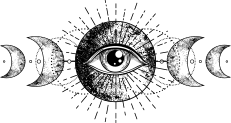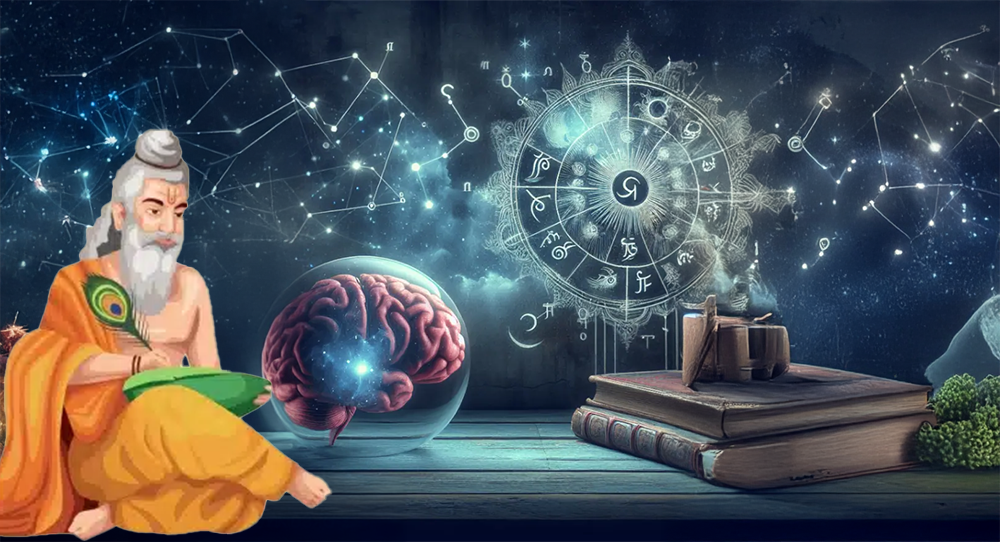The Divine Science of Jyotisha
Origins, Philosophy & Purpose
In the sacred tapestry of Sanatana Dharma, Jyotisha Shastra is not merely a tool for prediction—it is a divine science that reveals the cosmic order, guiding humanity toward dharma, harmony, and liberation. Rooted in the Krishna Yajurveda and refined through the Vedanga Jyotisha, this ancient wisdom remains one of the most profound yet underexplored aspects of Vedic knowledge.
Sanatana Dharma and it's Origins
Sanatana Dharma, the eternal way, is not a religion but a cosmic framework of truth, dharma, and liberation. Jyotisha finds its origin in this dharmic tradition, where time (Kāla) is revered as a manifestation of Bhagavan Narayana Himself. The Vedanga Jyotisha, attributed to sage Lagadha, is one of the earliest texts that codifies astronomical and astrological principles, serving as a limb of the Vedas.
In the Krishna Yajurveda, time is not linear but cyclical—marked by Yugas, Muhurthas, and Nakshatras—each pulsating with divine energy. Jyotisha was born to help humans navigate this cosmic dance, ensuring that actions (karma) are performed in harmony with celestial rhythms.
Sanatana Dharma views the universe as a manifestation of Rta—the cosmic order upheld by Dharma. Jyotisha is the science that deciphers this order through the movements of celestial bodies.
Yathā śāstram tathā kāryam, yathā kālam tathā phalam
As per the scriptures should actions be done; as per time shall be the fruit.
— Vedic Proverb
The Vedanga Jyotisha, attributed to Rishi Lagadha, begins with a reverent invocation:
Yajñānāṁ lakṣaṇaṁ kālaḥ, saṁvatsaraḥ pravartate
Time is the measure of sacrifices; the year begins its course.
— Vedanga Jyotisha, Verse 1
This highlights Jyotisha’s original purpose: to determine the correct timing for Vedic rituals, ensuring they are performed in harmony with cosmic forces.
Krishna Yajurveda: The Hidden Source of Jyotisha Wisdom
While most mainstream discussions focus on Rig or Atharva Vedic references, the Krishna Yajurveda holds profound insights into Jyotisha. It speaks of the Aditya Mandala, the solar realm, and the Nakshatra Devatas, celestial beings governing human destiny. The Yajurvedic rituals are deeply time-sensitive, and Jyotisha was the guiding light to determine the most auspicious timings (Shubha Muhurtha) for these sacred acts.
The Taittiriya Samhita and Taittiriya Brahmana, key texts of the Krishna Yajurveda, describe the importance of lunar phases, solar transitions, and planetary movements in the performance of yajnas. This reveals Jyotisha not as a predictive tool, but as a dharmic compass—ensuring that every act is aligned with cosmic order.
The Krishna Yajurveda, particularly the Taittiriya Samhita, contains subtle references to celestial phenomena and their spiritual significance.
Ādityād vai ahorātram jāyate
From the Sun indeed are day and night born.
— Taittiriya Samhita 7.4.8
This verse reflects the Vedic understanding of time as a divine emanation from Surya, the solar deity. Jyotisha uses this framework to calculate Muhurthas, Tithis, and Nakshatras, aligning human actions with divine rhythms.
Another profound verse from the Taittiriya Brahmana:
Nakṣatrāṇām aham śaśī
Among the stars, I am the Moon.
— Krishna Yajurveda, Taittiriya Brahmana
This reveals the Moon’s central role in Jyotisha, governing the mind, emotions, and the unfolding of karma through its phases and transit.
Jyotisha Shastra: Philosophy Beyond Prediction
At its core, Jyotisha is a Vedantic science. It teaches that the soul (Atman) is eternal, but its journey through lifetimes is shaped by karma, which unfolds through time. The planets (Grahas) are not mere celestial bodies—they are Chaitanya Shaktis, conscious forces that administer karmic results.
The twelve houses (Bhavas), nine planets (Navagrahas), and twenty-seven constellations (Nakshatras) form a divine matrix. Each chart (Janma Kundali) is a blueprint of karma, revealing not just what will happen, but why it happens, and how one can transcend it through dharma, devotion, and spiritual practice.
Jyotisha is deeply philosophical. It teaches that the Grahas (planets) are not inert masses but Chaitanya Shaktis—conscious agents of karma.
Grahaḥ karmaphalado daivajñena nirūpitaḥ
The planet is the giver of karmic fruits, discerned by the astrologer.
— Jyotisha Shastra
Each Janma Kundali (birth chart) is a map of karma, revealing the soul’s journey and its dharmic obligations.
Kālaṁ nārāyaṇaṁ vidyāt
Know Time as Narayana Himself.
— Vishnu Purana
This verse elevates Jyotisha to a spiritual practice—where understanding time is akin to understanding the divine.
Purpose of Jyotisha in Modern Life
In today’s fast-paced world, Jyotisha offers a return to cosmic mindfulness. It helps individuals:
- Choose auspicious timings for life events (Vivaha, Griha Pravesha, Upanayana).
- Understand karmic patterns and life lessons.
- Align with dharma through remedial measures (Pariharas) like mantra, dana, and vrata.
- Deepen spiritual practice by syncing sadhana with planetary energies.
At Sri Veda Gayathri Jyothishalayam, we honor this sacred science not as superstition, but as spiritual guidance rooted in Vedic authority and divine compassion.
Conclusion: Jyotisha as a Path to Moksha
Jyotisha is not about controlling fate—it is about understanding it, harmonizing with it, and ultimately transcending it. When practiced with humility and devotion, it becomes a path to moksha, guiding seekers toward liberation through the light of divine knowledge.
Jyotiṣām ayanaṁ jñātvā, karmaṇām phalam āpnuyāt
By knowing the path of the stars, one attains the fruits of karma.
— Jyotisha Siddhanta
Let us honor Jyotisha not as superstition, but as a divine science of light, born from the Vedas, guided by Rishis, and blessed by the eternal Dharma.
Previous Story



